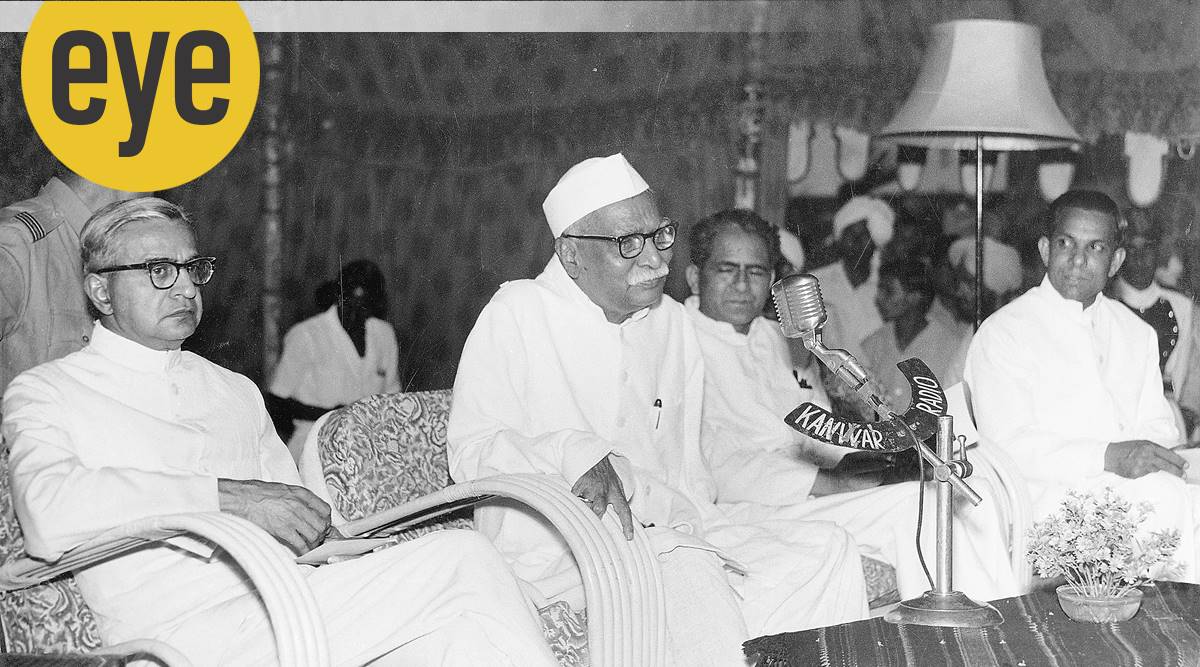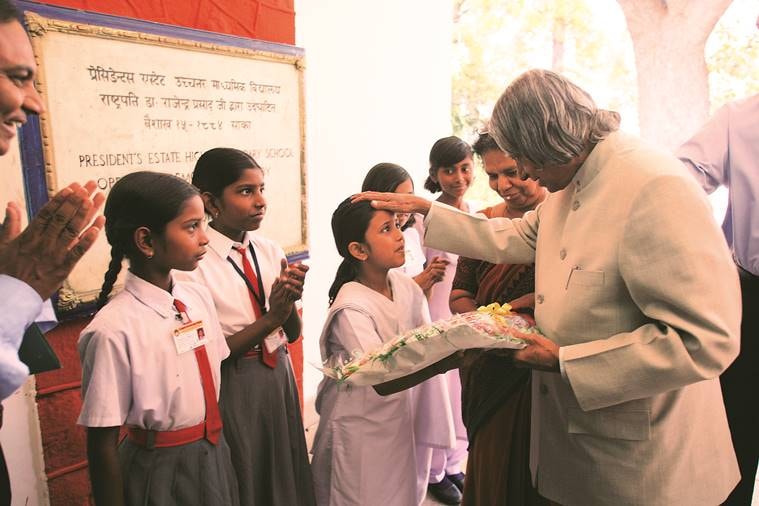 Rajendra Prasad at the opening ceremony of the President’s Estate School’s new building. (Photo courtesy: Rashtrapati Bhavan Photo Archives)
Rajendra Prasad at the opening ceremony of the President’s Estate School’s new building. (Photo courtesy: Rashtrapati Bhavan Photo Archives) This school within the Rashtrapati Bhavan straddles heritage and knowledge with equal ease. The building evokes a past that defines the very contours of the republic, and with heritage comes memories.
The history of India’s freedom struggle is often taught through its monuments and personalities. Students of the Dr Rajendra Prasad Kendriya Vidyalaya are in an enviable position as they learn that history sitting within the premises of one of those monuments. Be it geography, political science, botany or zoology, it is one of the most conducive campus to study in.
Located within the sprawling President’s Estate alongside the Rashtrapati Bhavan, the school sits in one of the most picturesque areas of the Capital. A drive through the lush green parks leads you to the school. The President’s Estate is almost a mini township. The school provides education to hundreds of children, mostly of the employees and of others outside the grounds. The Vidyalaya has an open-arm policy of welcoming wards of all central-government employees, subject to the availability of seats, with preference to the wards of employees of the President’s Secretariat and the military units based on the campus.
It was in the fall of 1946, when the First Earl Wavell, Archibald Percival Wavell, was the viceroy, that a need was felt for a school within the Viceregal Estate (as it was known then), as numbers of people working in the Government House grew. Initially, it was only a primary school for children of the age group from five to 12 years. The school was run by the education department of the government of India, which appointed and paid the teachers. After Independence, in April 1949, the management of the school was handed over to the chief commissioner of the Delhi administration. The primary school was upgraded to the middle level in May 1952 and, in July 1958, a reference was made by the Secretariat to the Directorate of Education, Delhi, to raise it to the higher-secondary level. It was eventually expanded and inaugurated by President Rajendra Prasad in 1962.
The school continued to upgrade its facilities for students over time. Tajinder Sharma, a London-based alumnus of the school, fondly recounts how president Zakir Hussain had inaugurated a central-announcement system, the first-of-its-kind in the country, and provided a water cooler for students.
 APJ Abdul Kalam visiting Dr Rajendra Prasad Sarvodaya Vidyalaya. (Photo courtesy: Rashtrapati Bhavan Photo Archives)
APJ Abdul Kalam visiting Dr Rajendra Prasad Sarvodaya Vidyalaya. (Photo courtesy: Rashtrapati Bhavan Photo Archives)
Considering the regional diversity among employees at the Rashtrapati Bhavan Estate, the President’s Secretariat on June 12, 2019, decided to convert the school into a Kendriya Vidyalaya under a special project. Among the most interesting features of this school are the tutorials given by successive presidents over seven decades. Many have taken keen interest in the activities of the school, often dropping by and interacting with children, and inviting them for a tour of the Rashtrapati Bhavan and Mughal Gardens. Every new initiative, be it the inauguration of the knowledge hub or a cricket field, has been marked with the visit of the president and other eminent personalities. For instance, the sprawling cricket ground facing the school building frequently hosts matches between the teams of various departments of the President’s Estate. It was inaugurated by president Pranab Mukherjee in 2013. That day, he picked up a bat, took a strike and played a few shots, too – much to the merriment of all.
Some 80 students, then in Classes XI and XII, would recall with pride that it was president Mukherjee who taught them on Teachers’ Day (September 5), for two consecutive years in 2015 and ’16. Their seniors would narrate how president APJ Abdul Kalam did not need any special occasion to come to the school. Sitting in the teacher’s chair behind the desk, he would talk about cultivating a scientific spirit. Students and teachers continue to cherish memories of his dynamic lectures on a varied range of issues.
Last year, on February 10, President Ram Nath Kovind visited the Vidyalaya. He walked into laboratories, and spoke with students and teachers to motivate and inspire them and to ensure that academics, sports, fine arts and performing arts are all given due importance. The President took special care to put students at ease by encouraging them to ask him questions.
 President Ram Nath Kovind interacting with students at the school. (Photo courtesy: Rashtrapati Bhavan Photo Archives)
President Ram Nath Kovind interacting with students at the school. (Photo courtesy: Rashtrapati Bhavan Photo Archives)
The students launched into a barrage of queries, which the President patiently answered. One such was from a student of Class V, who asked that if given the opportunity to become a child again, what would he do? The President answered, “Although it is possible only in a dream to become a child again but if it ever happens, I would take admission in Dr Rajendra Prasad Kendriya Vidyalaya and study and play with you all.” Perhaps, no other institution in India can claim to have this exclusive privilege of having such close interactions between the first citizens of the country and the students.
Memories lose their relevance if they are not preserved with a scientific approach. In the course of this school’s journey, the augmentation of infrastructure and modernisation of labs was carried out to inculcate a scientific spirit among its pupils. Currently, the school is furnished with the latest amenities, smart classrooms, Intel lab, computerisation of all academic and administration work, smart-resource rooms for primary and secondary sections, introduction of Artificial Intelligence, along with co-curricular and sports facilities. It is also one of the Capital’s first solar-powered green school, LED-lit by the electricity generated using green technologies. The school’s development plan conforms to the vision of the successive occupants of the Rashtrapati Bhavan, which is veritably a lighthouse to guide the journey of the republic.
- The Indian Express website has been rated GREEN for its credibility and trustworthiness by Newsguard, a global service that rates news sources for their journalistic standards.
 Continue with Facebook
Continue with Facebook Continue with Google
Continue with Google
